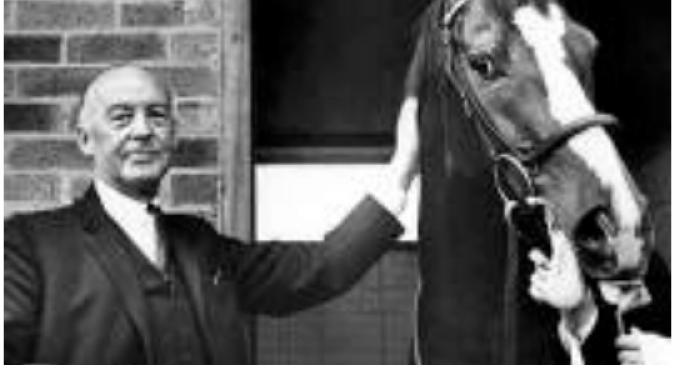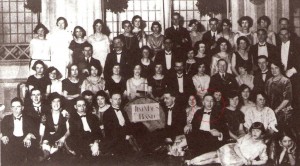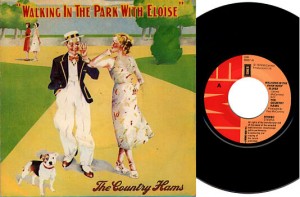

James “Jim” McCartney (7 July 1902 – 18 March 1976) was the father of musician, author and artist Sir Paul McCartney of the Beatles and Wings, and photographer and musician Mike McCartney, who worked with the Scaffold.
Like many families in Liverpool, the McCartney family is of Irish descent. Jim worked for most of his life in the cotton trade, as well as playing in ragtime and jazz bands in Liverpool.
The McCartney family lived in council houses during the 40’s and 50’s, but Paul later bought his father a house called Rembrandt, in Heswall, Cheshire. Jim encouraged his two sons to take up music by buying instruments for them to learn, as well as improving their education. After his first wife Mary’s death in 1956, Jim married Angela Williams on November 24th 1964, and adopted her daughter from a previous marriage, Ruth McCartney.
Follow Jim McCartney on Pinterest.
Jim was born at 8 Fishguard Street, Everton, Liverpool and was the third eldest of seven children. The McCartney children were John (Jack), Edith, James (Jim), Ann, Millie, Jane (Jin) and Joe (who was named after a brother who died in infancy). Joe and Florrie McCartney moved shortly after Jim’s birth to 3 Solva Street in Everton, which was a run-down terraced house about three-quarters of a mile from the Liverpool city centre, where Jim attended the Steers Street Primary School off Everton Road. After leaving school at 14, Jim found work for six shillings a week as a cotton “sample boy”, at A. Hanney & Co.; a cotton broker in Chapel Street, Liverpool. Jim’s job entailed running up and down Old Hall Street with large bundles of cotton that had to be delivered to cotton brokers or merchants in various salesrooms. He worked ten-hour days, five days a week, although he received a bonus at Christmas that was almost double his annual salary.
When World War II started Jim was too old to be called up for active service, as well as having previously been disqualified on medical grounds after falling from a wall and smashing his left eardrum when 10 years old. After the cotton exchange closed for the duration of the war, Jim worked as an inspector at Napier’s engineering works, which made shell cases that were later filled with explosives. He volunteered to be a fireman at night and often watched Liverpool burning from his rooftop observer’s position. Between 1940 and 1942, Liverpool endured 68 air-raids, which killed or injured more than 4,500 of the population and destroyed more than 10,000 homes. After the war he worked as an inspector for Liverpool Corporation’s Cleansing Department before returning to the cotton trade in 1946.
Jim avidly read the Liverpool Echo and Daily Post, liked solving crosswords and instigated discussions about varied subjects. His attitude to life was based upon self-respect, perseverance, fairness and a strong work ethic. His political views were far from left-wing, as he insisted that there was nothing anyone could do about the situation the working classes were in at the time, and nothing would ever change.
MUSIC :: Joe McCartney, Jim’s father, was a traditionalist who liked opera and played an E-flat tuba in the local Territorial Army band that played in Stanley Park, and the Copes’ Tobacco factory Brass Band where he worked. He also played the double bass at home, sang, and hoped to interest his children in music.[58] Jim learned how to play the trumpet and piano by ear, and at the age of 17 started playing ragtime music. Joe McCartney thought that ragtime—the most popular music of the period—was “tin-can music”. Jim’s first public appearance was at St Catherine’s Hall, Vine Street, Liverpool, with a band that wore black masks as a gimmick, calling themselves the Masked Melody Makers. He later led Jim Mac’s Jazz Band in the 1920s, with his brother Jack on trombone, and composed his first tune, “Eloise”. Paul would later record it as, “Walking in The Park With Eloise”.
Jim had an upright piano in the Forthlin Road front room that he had bought from Harry Epstein’s North End Music Store (NEMS) and Brian Epstein, Harry’s son, later became The Beatles’ manager.
Jim had a collection of old, 78 rpm records that he would often play, or perform his musical “party-pieces”—the hits of the time—on the piano. He used to point out the different instruments in songs on the radio to his sons, and took them to local brass band concerts. Jim also taught them a basic idea of harmony between instruments, and Paul credits Jim’s tuition as being helpful when later singing harmonies with Lennon. After Mary’s death, Jim bought Paul a nickel-plated trumpet as a birthday present.When skiffle music became popular, Paul swapped the trumpet for a £15 Framus Zenith (model 17) acoustic guitar. Paul also played his father’s Framus Spanish guitar when writing early songs with Lennon.
With encouragement from Jim, Paul started playing the family piano and wrote “When I’m Sixty-Four” on it. Jim advised Paul to take some music lessons, which he did, but soon realised that he preferred to learn ‘by ear’ (as his father had done) and because he never paid attention in music classes.[69][70] After Paul and Michael became interested in music, Jim connected the radio in the living room to extension cords connected to two pairs of Bakelite headphones so that they could listen to Radio Luxembourg at night when they were in bed.
After first meeting Lennon, Jim warned Paul that he would get him “into trouble”, although he later allowed The Quarrymen to rehearse in the dining room at Forthlin Road in the evenings. Jim was reluctant to let the teenage Paul go to Hamburg with The Beatles until Paul said the group would earn £15 per week each. As this was more than he earned himself, Jim finally agreed, but only after a visit from the group’s then-manager, Allan Williams, who said that Jim should not worry. Jim was later present at a Beatles’ concert in Manchester when fans surrounded drummer Pete Best, and ignored the rest of The Beatles. Jim criticised Best by saying, “Why did you have to attract all the attention? Why didn’t you call the other lads back? I think that was very selfish of you”. Bill Harry recalled that Jim was probably “The Beatles’ biggest fan”, and was extremely proud of Paul’s success. Shelagh Johnson—later to become director of The Beatles’ Museum in Liverpool—said that Jim’s outward show of pride embarrassed his son. Jim enlisted Michael’s help when sorting through the ever-increasing sacks of fan letters that were delivered to Forthlin Road, with both composing “personal” responses that were supposedly from Paul. Michael would later have success on his own with the group The Scaffold.
62-year-old Jim was earning £10 a week in 1964, but Paul suggested that his father should retire, and bought “Rembrandt”~ a detached mock-Tudor house in Baskervyle Road, Heswall, Cheshire, for £8,750. He bought his father a horse called “Drake’s Drum”, and a couple of years later, the horse won the race immediately preceding the Grand National.
Jim died of bronchial pneumonia and complications of Rheumatoid Arthritis on 18 March 1976. His second wife, Angela McCartney (née Williams) said that his last words were “I’ll be with Mary soon.” Jim died two days before a Wings European tour so his eldest son was unable to attend the funeral. Jim was cremated at Landican Cemetery, near Heswall, Merseyside on 22 March 1976.
Read more Jim stories, sayings and anecdotes in Angie McCartney’s Book “My Long & Winding Road”.




